At the literal center of Texas, Bell County is something of an unsung hero when it comes to both the population and the economy. Outside of the triangle of Houston, DFW, and Austin/San Antonio, Bell County also stands apart from major counties like Hidalgo and El Paso. Bell County is one of the most populous in Texas and has become much more urbanized in the past decade. With economic activity shifting and healthy population growth, things are looking bright for Bell County. The only real complication from these beneficial changes has been a rapid increase in property values and the ensuing taxes, which has haunted Texas as a whole.
While property taxes have almost doubled in Bell County in the past decade, residents have been fighting back with increasing tax appeals. In 2023, 14.81% of all properties in the county had been protested, and this trend seems to be moving ever-upward. After a long season of protests, the final numbers for both informal and formal appeals have been tallied, and in this article, we will compare how appeals dealt with recent tax increases, demonstrating how big of a difference the protests made. We will also point out how O’Connor was able to help our clients in their own protest journey.
Combined Appeals Trim Over $320 Million in Taxable Value from Homes
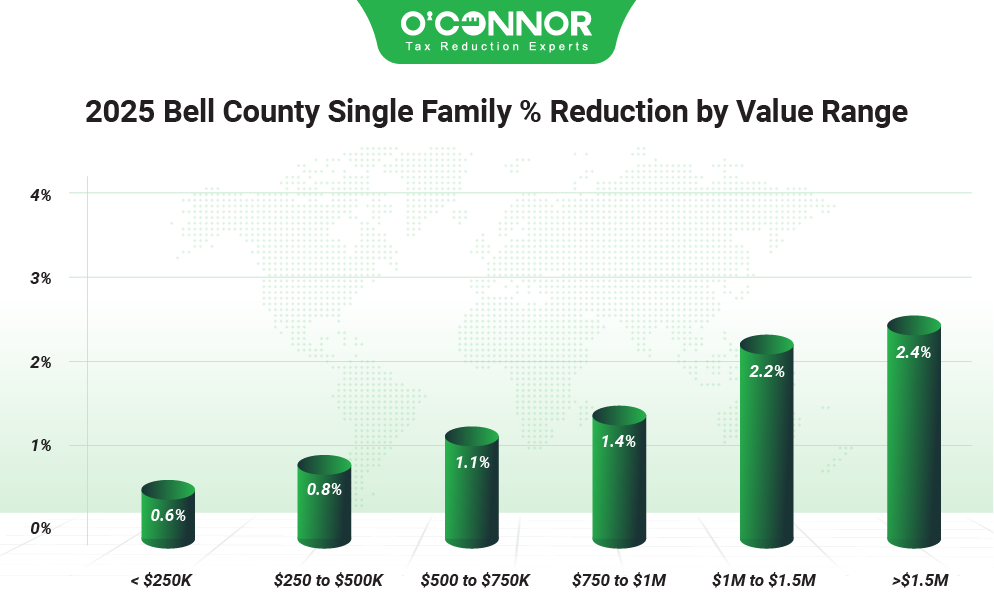
Homeowners in Bell County experienced a strong rise in overall home value in 2025, with a jump of 3.6%. This took the grand total to $35.41 billion. It was also estimated by Tax Appraisal District of Bell County (Bell CAD) that 38% of all homes were overvalued. After both informal and formal protests, the total value was reduced by 0.9% to $35.09 billion. The largest block of value in the county came from homes worth between $250,000 and $500,000, which had a final total of $16.73 billion after a cut of 0.8%. Homes under $250,000 were second with $10.04 billion after a decrease of 0.6%. In general, the more expensive the property, the larger the reduction. This culminated in a decrease of 2.4% for homes worth over $1.5 million. We at O’Connor joined our clients in their tireless fight, and together we were able to lower their taxable value by 2.9%, easily exceeding the county number of 0.9%.
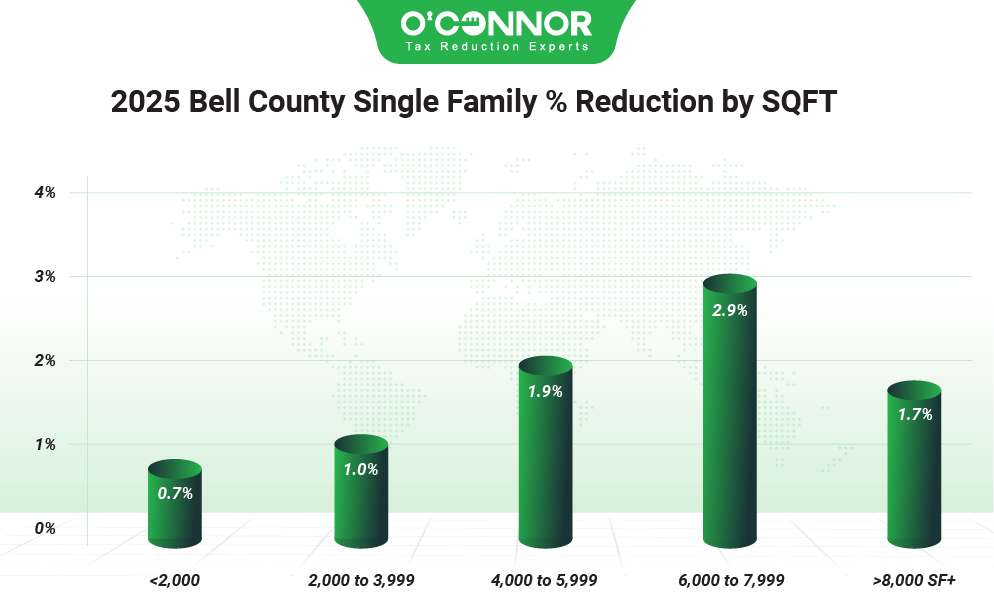
When looked at by size, the breakdown of value can be better understood. In a mathematical anomaly, the two top categories were virtually identical in value. Homes measured at under 2,000 square feet accounted for $16.62 billion, while those between 2,000 and 3,999 square feet were responsible for $16.85 billion. These had received reductions of 0.7% and 1% respectively. Those between 4,000 and 5,999 square feet saw a decrease of 1.9%, totaling $1.16 billion. The largest appellant victory came for homes between 6,000 and 7,999 square feet, which scored a decrease of 2.9%. Truly massive homes only landed a decrease of 1.7%, breaking the trend established by worth.
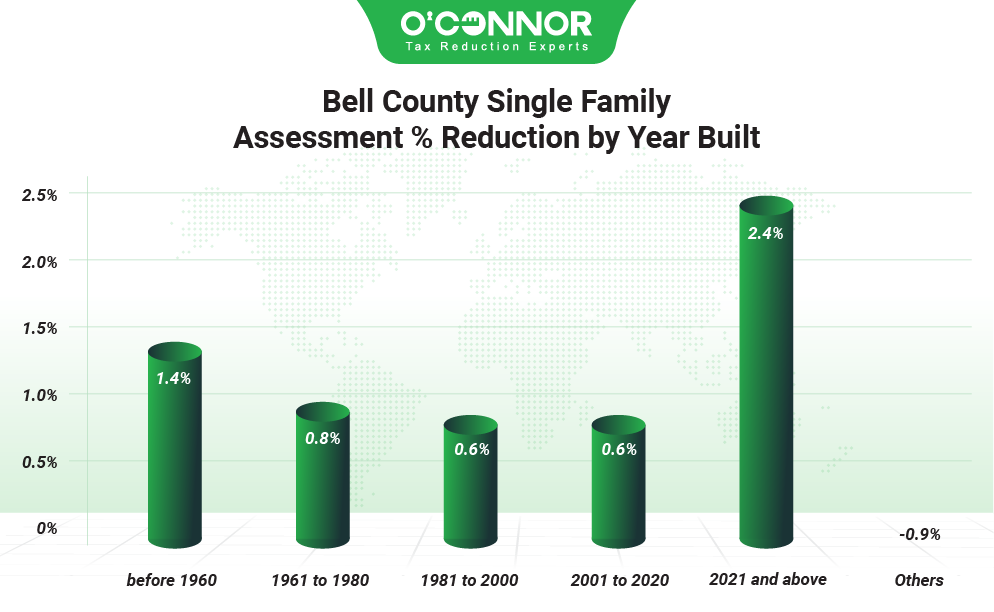
Homes in Bell County tend to trend toward recent construction, which is pretty common in Texas. The largest group of homes was built between 2001 and 2020, accounting for 47.6% of all value, or $16.70 billion. This was followed by homes from 1981 to 2000, which contributed $6.92 billion. These saw their value depleted by 0.6% each. New construction was not only the fastest-growing category but also managed to be responsible for 13.4% of the total, thanks to reaching $4.71 billion following a cut of 2.4%. These new properties had previously added 28.6%. Land, classified as “other” by Bell CAD, experienced a small increase.
O’Connor Clients Save Double Over the County Number for Commercial Appeals
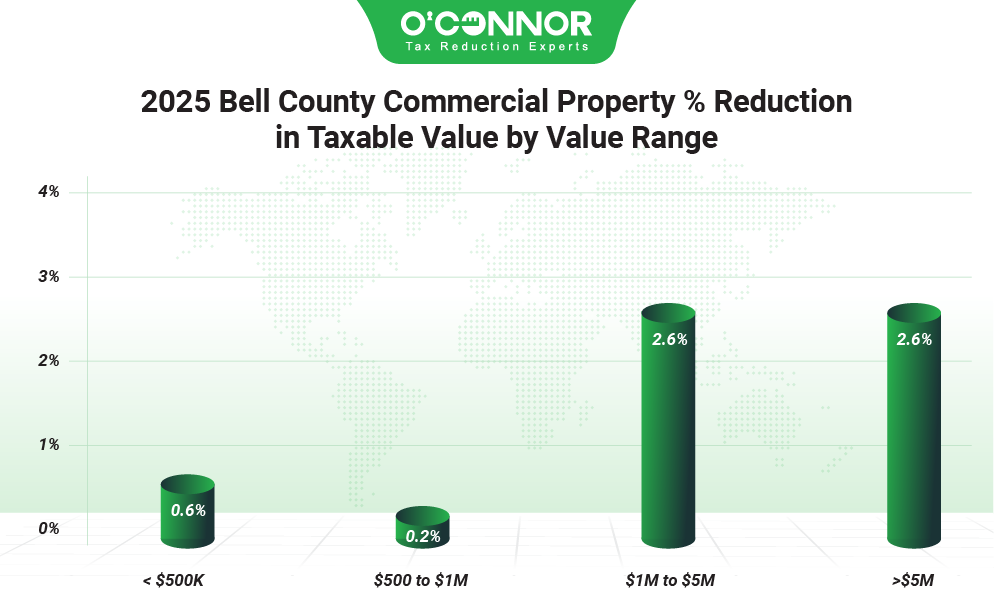
There has been significant economic growth in Bell County in recent years, though that can be difficult to separate from overvaluation by Bell CAD. 9.9% more taxable value was added in 2025 for business properties, taking the total to $10.87 billion. The dual threat of informal and formal protests managed to diminish this 2% to $10.66 billion. The largest contributor, business real estate worth over $5 million, also netted the biggest reduction with 2.6%. This gave a new sum of $4.60 billion. It is typical in Texas for commercial properties in this range to own 40% or more of the value, so Bell County was right on the money. After another drop of 2.6%, properties worth between $1 million and $5 million combined for a final result of $1.27 billion. We at O’Connor often focus on commercial properties and were able to assist our clients by getting an overall reduction of 4.8%.
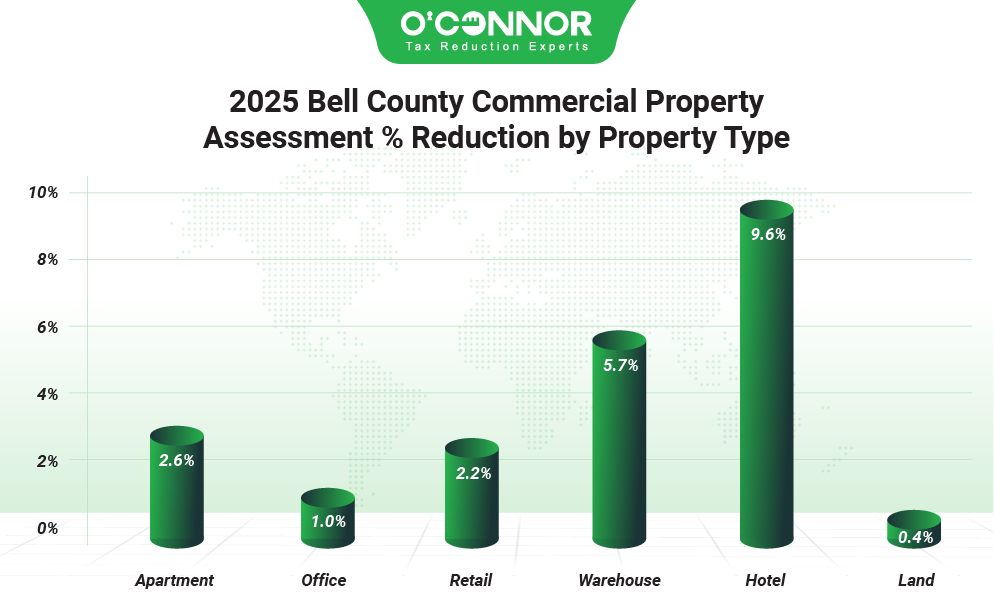
Like many developing counties, the biggest holder of commercial value was raw land at $5.51 billion. This is certainly a solid indicator of future growth and also helps justify the rising price of real estate. Raw land saw a minor reduction of 0.4%. Apartments, usually the No. 1 in Texas, were in second with $1.62 billion after being lowered by 2.6%. Warehouses were surprising No.3 with a combined worth of $1.45 billion after a decrease of 5.7%, helping offset a massive increase of 24.5%. Retail properties combined for $872.54 million, while offices added up to $802.71 million. These were reduced by 2.2% and 1% respectively. The highest percentage drop was for hotels, with a decrease of 9.6%.
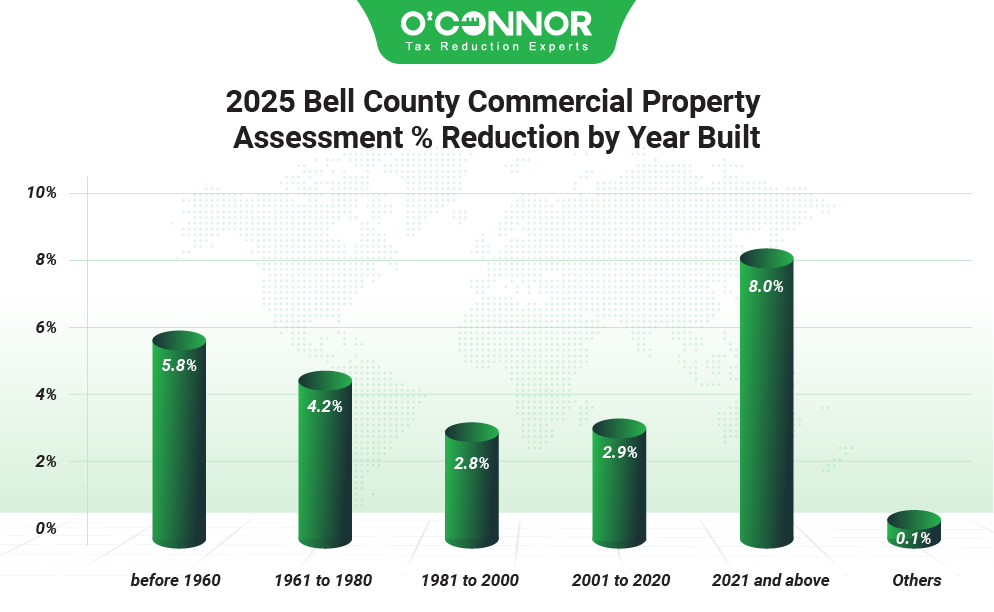
Commercial real estate typically follows residential properties when it comes to time of construction. While 51% of the value was tied up in land, the main source of developed property value was those built from 2001 to 2020. These recent buildings were valued at $2.50 billion after a cut of 2.5%. 1981 to 2000 construction saw a decrease of 2.8% but still added up to $1.16 billion. Older buildings managed a good showing, with those built from 1961 to 1980 dropping 4.2% to $727.17 million. New construction jumped up by 76% in 2025, though appeals managed to slow it a bit with a reduction of 8%. This resulted in a final figure of $700.06 million.
Apartments Use Protests to Cut $42.55 Million in Value
Apartments were not only the No. 1 commercial building type in the county but also added 10.2% to their value in 2025. This was quickly countered with various appeal types, and after a slice of 2.6% was taken off, the new sum was $1.62 billion. $570.28 million of this came from buildings constructed between 2001 and 2020, following a solid cut of 4.7%. Construction from 1981 to 2000 produced $367.03 million after a decrease of 1.4%. New construction saw a massive jump of 72%, reaching a total of $342.27 million, following a small decrease of 0.3%. Older buildings were right behind, with those constructed from 1961 to 1980 accounting for $298.38 million. O’Connor was able to achieve an overall reduction of 3.8% for these key properties.
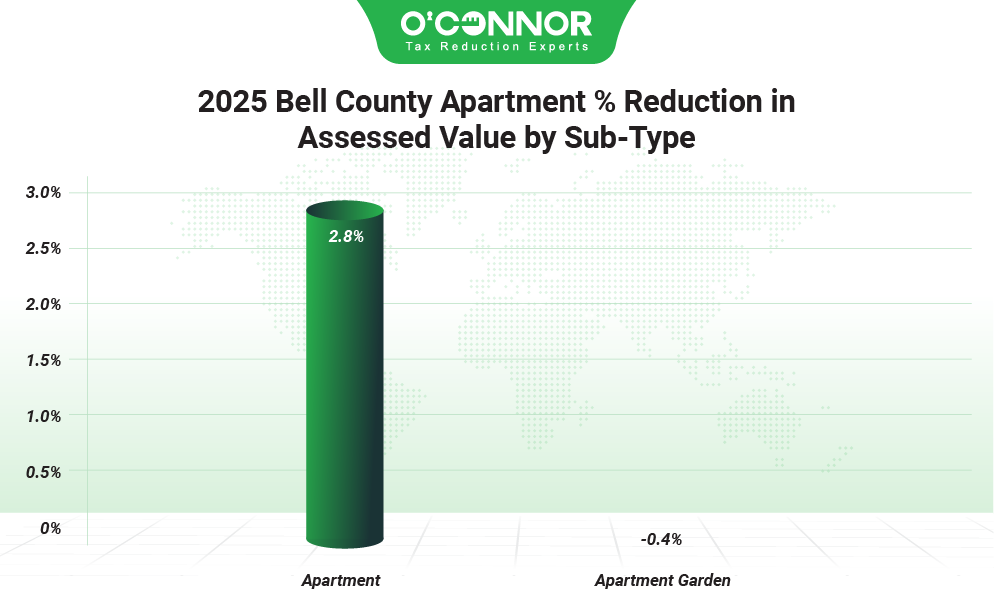
Despite their usual variety, Bell CAD only divided apartments into two different categories. Generic apartments were the largest of the two by far, totaling $1.48 billion after a cut of 2.8%. Garden apartments did not see any meaningful cuts, starting and ending with around $135.47 million.
Historic Warehouse Rise Stemmed by Protests
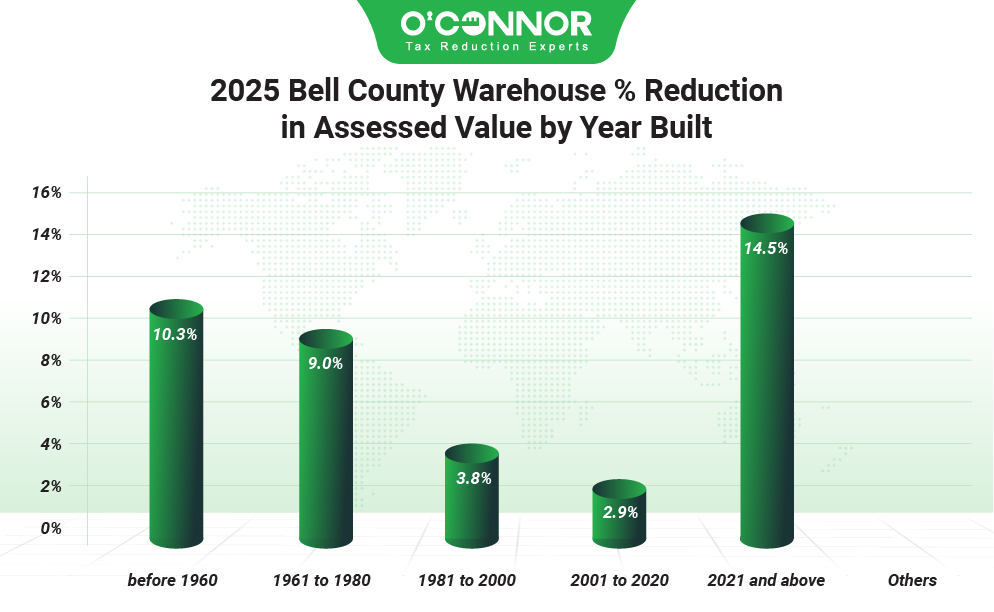
Out of all commercial properties in Bell County, none grew faster than warehouses. These are usually the quiet engines of industry and are a good indicator of the health of an economy. Growing 24.5% in 2025, warehouses achieved a total of $1.54 billion. The biggest reason for this was a giant spike of 137% for new construction, which ended up giving a pre-appeal total of $265.28 million. Appeals were able to take a bite out of this increase, with an overall reduction of 5.7% dropping the total to $1.45 billion. A savings of 14.5% was applied to new construction, bringing it down to $226.79 million. The largest timeframe regarding value was for warehouses that were constructed between 2001 and 2020, which was accountable for $837.01 million after a trimming of 2.9%. O’Connor clients experienced a larger slicing to the overall value, getting back 7.9%.
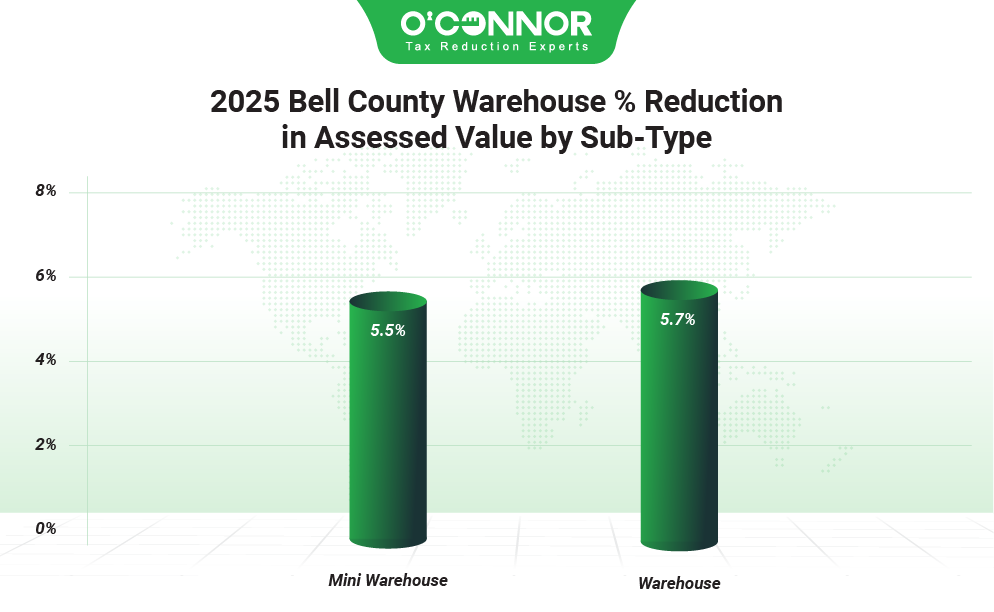
Like apartments, Bell CAD had only two subtypes for warehouses. Generic warehouses dominated in total value, being accountable for $1.26 billion after a solid reduction of 5.7%. Mini warehouses were cut by 5.5% for a combined sum of $188.30 million.
Plenty of Potential for Appeals in Bell County
Bell County is in many ways a hybrid of various county types in Texas. There are some aspects of high-dollar counties like Travis or Fort Bend, and there are some factors from working-class counties like El Paso and Hidalgo. There was significant growth in housing and commercial values, but not ridiculous spikes. Likewise, there were strong protest numbers and savings, but there was room for improvement. High-dollar counties tend to protest over 30% of properties, while modest counties may protest under 9%. Bell County was in the middle of all of these. Engagement with appeals is on the rise, and they are seeing strong results, but there needs to be more of them. Taxpayers that did appeal saw excellent results, so this will hopefully encourage more residents to exercise their rights.
If you are still debating about protesting your taxes in 2026, we at O’Connor are here to help. Based in Houston, we have been fighting CADs across Texas for over 50 years. We are one of the largest property tax consulting firmss in the nation, helping 185,000 clients in 2024 alone. In Bell County, we were able to beat the county numbers easily and saved our clients a combined $11.95 million. There is never an upfront fee or hidden cost to enroll with us, and we will even protest your property taxes for you annually at no cost. You are only ever charged a fee on your winnings if we are able to lower your taxes. Your values cannot be increased if your appeal fails, so there is truly no downside or risk to exploring your options.

